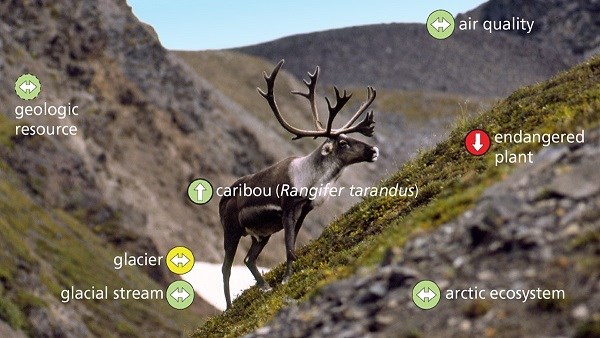
NPS Photo by R Proenneke 1980
While the scope of both the resources and the reporting products may vary, the general mechanisms involved in composing an NRCA are similar. NRCAs follow these basic steps:
-
Choose which park resources will be considered.
-
Identify potential indicator species; animal or plant species that can be used to infer conditions in an ecosystem.
-
Gather all available data and research in and around parks.
-
Review information and look for how it has changed relative to a standard, measured or historic baseline.
-
Determine if there is enough data to assign a condition. Do we know enough? Are there critical data gaps where future efforts should be focused?
-
Determine trends in data for resources where data is available over time.
View NRCA Products by Park:
Alagnak Wild River
Alibates Flint Quarries National Monument
Allegheny Portage Railroad National Historic Site
American Memorial Park
Amistad National Recreation Area
Aniakchak National Monument & Preserve
Aztec Ruins National Monument
Badlands National Park
Bandelier National Monument
Bent's Old Fort National Historic Site
Big Bend National Park
Biscayne National Park
Big South Fork National River and Recreation Area
Big Thicket National Preserve
Blue Ridge Parkway
Bluestone National Scenic River
Booker T. Washington National Monument
Bryce Canyon National Park
Buck Island Reef National Monument
Cape Hatteras National Seashore
Catoctin Mountain Park
Cape Lookout National Seashore
Capitol Reef National Park
Carl Sandburg Home National Historic Site
Carlsbad Caverns National Park
Casa Grande Ruins National Monument
Cedar Breaks National Monument
Cedar Creek & Belle Grove National Historical Park
Channel Islands National Park
Chaco Culture National Historical Park
Chesapeake and Ohio Canal National Historical Park
Chickamauga and Chattanooga National Military Park
Chickasaw National Recreation Area
Colorado National Monument
Congaree National Park
Crater Lake National Park
Cumberland Gap National Historical Park
Cumberland Island National Seashore Cuyahoga Valley National Park
Denali National Park And Preserve
Death Valley National Park
Dinosaur National Monument
Dry Tortugas National Park
Ebey's Landing National Historical Reserve
Eisenhower National Historic Site
El Malpais National Monument
El Morro National Monument
Everglades National Park
Fort Davis National Historic Site
Fort Donelson National Battlefield
Fort Monroe National Monument
Fort Necessity National Battlefield
Fort Laramie National Historic Site
Fort Pulaski National Monument
Fort Larned National Historic Site
Fort Union Trading Post National Historic Site
Fossil Butte National Monument
Fort Vancouver National Historic Site
Fredericksburg and Spotsylvania County Battlefields Memorial National Military Park
Friendship Hill National Historic Site
First State National Historical Park
Gauley River National Recreation Area
Gateway National Recreation Area
George Washington Memorial Parkway
Gettysburg National Military Park
Gila Cliff Dwellings National Monument
Glacier Bay National Park and Preserve
Glen Canyon National Recreation Area
Golden Gate National Recreation Area
Golden Spike National Historic Site
Grand Canyon-Parashant National Monument
Grand Canyon National Park
Grand Portage National Monument
Grant-Kohrs Ranch National Historic Site
Great Basin National Park
Great Sand Dunes National Preserve
Great Smoky Mountains National Park
Guadalupe Mountains National Park
Guilford Courthouse National Military Park
Haleakalā National Park
Harriet Tubman Underground Railroad National Historical Park
Harpers Ferry National Historical Park
Hawai'i Volcanoes National Park
Herbert Hoover National Historic Site
Hopewell Culture National Historical Park
Homestead National Historical Park
Horseshoe Bend National Military Park
Johnstown Flood National Memorial
John Muir National Historic Site
Joshua Tree National Park
Katmai National Park and Preserve
Kenai Fjords National Park
Sequoia and Kings Canyon National Parks
Lake Clark National Park and Preserve
Lake Mead National Recreation Area
Lake Meredith National Recreation Area
Lassen Volcanic National Park
Lava Beds National Monument
Lewis and Clark National Historical Park
Little Bighorn Battlefield National Monument
Lyndon B. Johnson National Historical Park
Mammoth Cave National Park
Marsh-Billings-Rockefeller National Historical Park
Manzanar National Historic Site
Martin Van Buren National Historic Site
Mississippi National River and Recreation Area
Mojave National Preserve
Montezuma Castle National Monument
Mount Rainier National Park
Morristown National Historical Park
National Park of American Samoa
Natchez Trace Parkway
New River Gorge National River
North Cascades National Park
Obed Wild and Scenic River
Ocmulgee National Monument
Olympic National Park
Oregon Caves National Monument & Preserve
Padre Island National Seashore
Petrified Forest National Park
Petersburg National Battlefield
Petroglyph National Monument
Pinnacles National Park
Pipestone National Monument
Point Reyes National Seashore
Prince William Forest Park
Pu'uhonua o Honaunau National Historical Park
Grand Canyon-Parashant National Monument
Russell Cave National Monument
Sand Creek Massacre National Historic Site
Saguaro National Park
Saint Croix National Scenic Riverway
Saint-Gaudens National Historical Park
San Juan Island National Historical Park
San Antonio Missions National Historical Park
Santa Monica Mountains National Recreation Area
Salinas Pueblo Missions National Monument
Saratoga National Historical Park
Salt River Bay National Historical Park and Preserve
Scotts Bluff National Monument
Sequoia and Kings Canyon National Parks
Shenandoah National Park
Shiloh National Military Park
Stones River National Battlefield
Sunset Crater Volcano National Monument
Theodore Roosevelt National Park
Timpanogos Cave National Monument
Timucuan Ecological & Historic Preserve
Tonto National Monument
Tumacacori National Historical Park
Tuzigoot National Monument
Valles Caldera National Preserve
Valley Forge National Historical Park
Vicksburg National Military Park
Virgin Islands Coral Reef National Monument
Virgin Islands National Park
Voyageurs National Park
Walnut Canyon National Monument
Weir Farm National Historic Site
White Sands National Monument
Wolf Trap National Park for the Performing Arts
Wrangell - St Elias National Park & Preserve
Wupatki National Monument
Source: NPS DataStore Collection 7765. To search for additional information, visit the NPS DataStore.
Last updated: September 26, 2024
